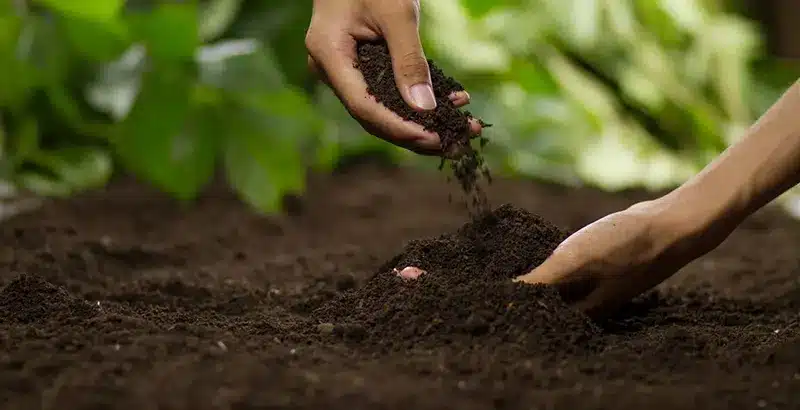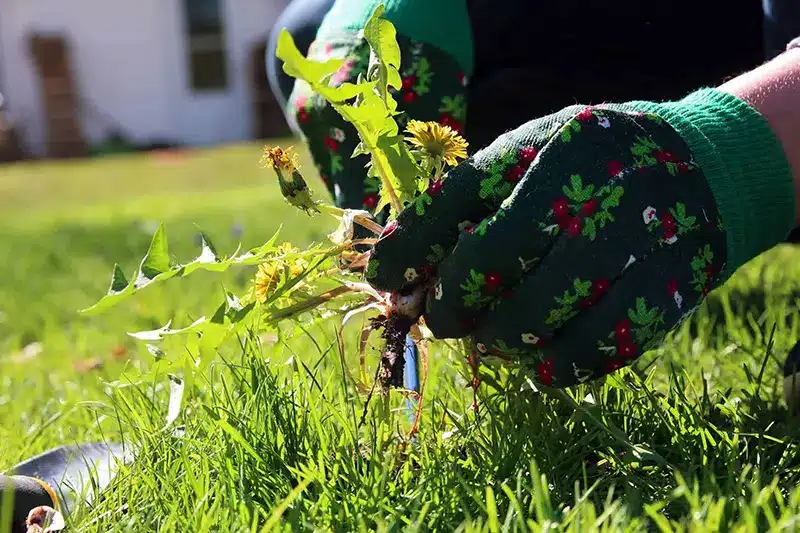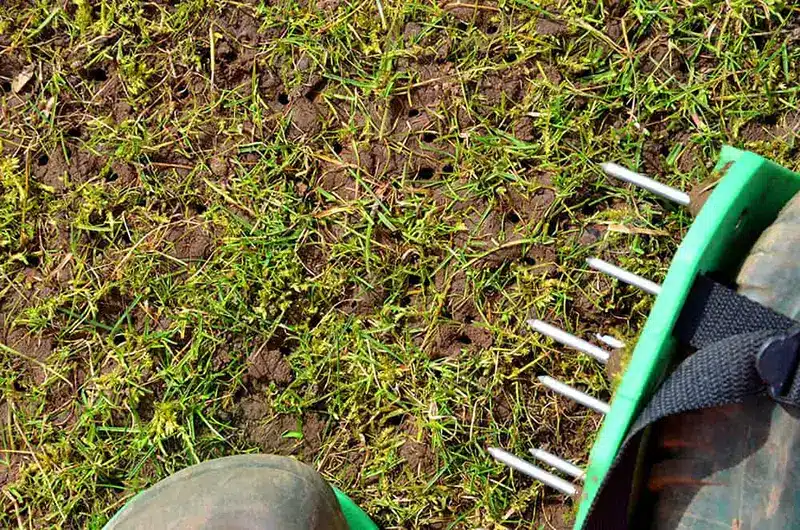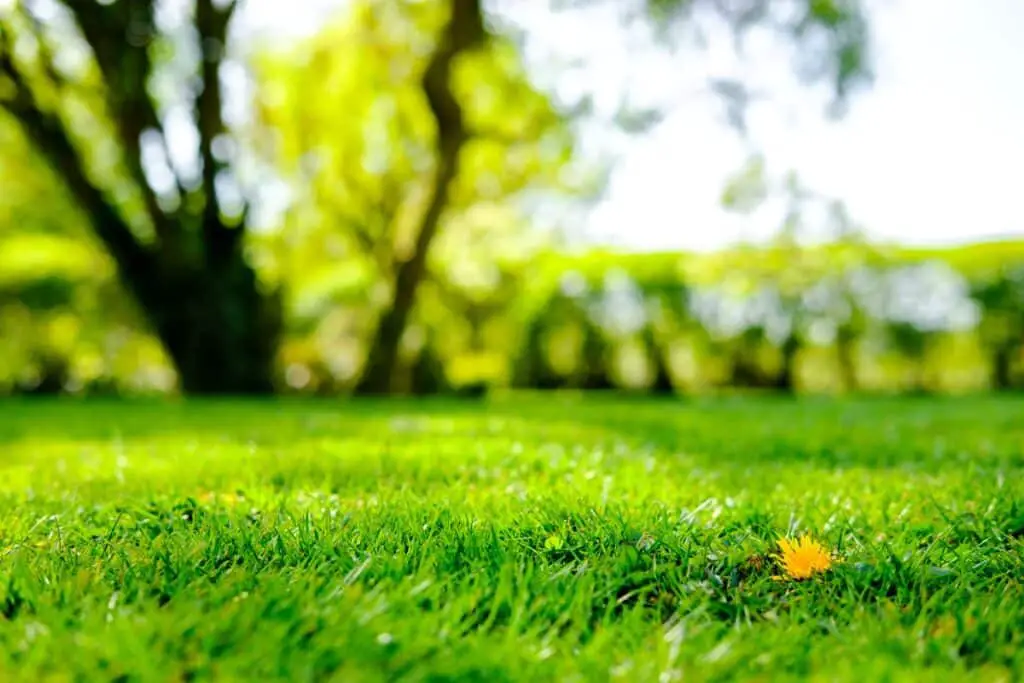Contrary to many claims, having a beautiful lawn does not need frequent applications of synthetic lawn fertilizers, insecticides, and herbicides. In fact, you can grow a healthy lawn without relying on those hazardous chemicals.
You can get a healthy natural lawn by opting for quality grass and making your soil better. Proper weed management, use of organic fertilizers, aerating, thatching, and composting help too.
To know more about these methods, read on.
Quick Navigation
- Is It Easy to Naturally Grow a Beautiful Lawn?
- 10 Basic Tips for A Healthy and Organic Lawn
- Sustainable & Natural Lawn Care: Additional Tips
- Conclusion
Is It Easy to Naturally Grow a Beautiful Lawn?

Lawns are outdoor play areas for both humans and animals. Lawns significantly reduce heat, provide oxygen, trap dust, encourage the growth of healthy microorganisms, reduce erosion, and filter pollutants. Plus, a healthy lawn can increase the value of your property.
Most healthy lawns have no weeds and a thick carpet of consistently green grass.
The good news is that you can achieve that type of lawn without harsh pesticides. And contrary to what you may be thinking, the entire process doesn’t cost a lot.
10 Basic Tips for A Healthy and Organic Lawn
You may end up with the healthiest grass on your lawn by following a few simple natural lawn care tips. Below is a list of things you should do:
Opt For Quality Grass
Planting suitable quality grass is the first step in creating the lawn of your dreams. You may get guidance from the local garden center on the ideal grass to put in your yard. You may also utilize a variety of cool-season grasses and warm-season grass like Bermuda grass.
It is essential to know the kind of environment-specific grasses thrive in, the water and nutrients they need, and the amount of wear they can sustain. These all differ across grasses.
Use the appropriate grass seed for your growing conditions, add organic matter, and adjust the soil pH. You may do a soil test with a testing kit from a gardening supply shop.
Strengthen Your Soil
Strengthening weaker soil is the first stage in converting an existing lawn to an organic one. This requires a soil test.
In this manner, you can determine the soil quality. You’ll know which nutrients are deficient and which organic changes you need to add. For instance, you can add gypsum to soil that lacks calcium.

Loamy soils with a mix of clay soils, silt, and sand are ideal for growing lawns. On the other hand, heavy usage or too much clay in the soil mixture might compress the soil, obstructing air and organic nutrient’s movement.
Healthy soil will benefit from organic matter, such as compost and grass clippings; it will lighten clay-heavy soil and produce humus in sandy soils, which aids in the retention of water and nutrients.
Mow Your Lawn Properly
You will damage your yard, mower blades, and machinery when you mow wet grass from morning dew or rain. You can quickly get a dull blade on wet grass! Additionally, since the grass below gets blocked, a mower must work twice as hard. Wet grass causes the blades to rip rather than cut.
You’re not doing your grass any favors by giving it a “marine cut”. The soil dries up more quickly, surface aeration decreases, and surface roots are exposed.
As a general rule, only remove one-third of the grass at a time. Cut the grass to around 2 inches (5.08 cm) after the growth season to reduce the chance of wintertime mold growth.
Water Properly
Your grass won’t benefit much from putting your sprinkler on for a few minutes a few times each week. Learn to water infrequently and thoroughly for a healthier lawn. Of course, this quantity may change based on the kind of soil, grass species, and local weather conditions.
When the top 3 to 4 inches (ca. 10 cm) of soil feel dry to the touch, it is time to water again. To check the soil’s moisture, use an electronic soil tester or open the soil with a shovel or screwdriver and feel it with your finger.
Remember that the morning and when there is no wind are the ideal times to water your lawn to lessen evaporation-related issues.
Conduct Regular Pest Inspections
Some beneficial insects are necessary for a healthy lawn because they may eat through the top layer of soil, allowing moisture, air, and nutrients to pass through.
However, some pests, such as white grubs and chinch bugs, may harm your grass. Regularly check your lawn for bug damage, and then take the necessary steps to keep pests away from it.
The best strategy to manage lawn pests is to accurately identify them, learn about their life cycles, and immediately and effectively treat them at the right time. Harm from lawn pests sometimes goes unseen and untreated until significant damage occurs.
Weed Management

Check your grass often for weed growth. Annual weeds may harbor pests and illnesses and compete with grass for moisture, sunshine, and nutrients.
Adding corn gluten meal is a less laborious option that also serves as a natural lawn fertilizer, especially for turf grass and organic crops. Add a second plant, such as white clover, to combat weed and restore the healthy soil in your lawn.
On the other hand, few weeds are beneficial plants, so do not take them out. Longer grass will naturally ward against weeds. Mowed turf grass reduces insects as well as weed pollen, grass seed, and spores.
Use Organic Fertilizers Instead
Organic fertilizers have been shown to function better than chemical fertilizers. Plus, they are healthier for the environment and your lawn.
According to recent research conducted by Austin’s Watershed Protection and Development Review Department and Texas A&M, natural and organic lawn fertilizers result in greener lawns than synthetic ones.
The best organic lawn fertilizers, often available at garden centers, include all-natural components like seaweed for potassium, bone for phosphorus, and feather meal for nitrogen.
Prevent Thatch Build-up
Dead grass may accumulate as a stiff layer on the soil surface of a lawn that receives excessive amounts of water, synthetic fertilizers, or pesticides and herbicides.
If it grows to a thickness of more than 1 cm, it may obstruct the deep roots’ access to nutrients, water, and air and serve as a breeding ground for pests and diseases.
Thatch is an aggregation of above-ground runners that the grass spreads. This layer of healthy grass should be around 1/2′′ thick and balanced by microbial activity, earthworms, and natural decomposition. Try to enhance aeration to reduce thatch buildup.
Aerate
It is time to aerate the grass when you notice that water does not permeate the lawn very well, there is a buildup of thatch, there is compacted soil, or there are weeds.

Making holes in it may improve nutrients, water, and air passage to the roots. If the grass is tiny, you may walk about on the grass while wearing your favorite aerating shoes. You can also utilize a dedicated lawn aerator for this.
Aerating your grass entails making 3-inch deep holes all over it. By doing routine lawn aeration, you may give your grass the ideal environment to flourish in, with loose soil and increased air circulation. Your grass needs aeration roughly once each year.
Compost
Composting is a terrific method to save waste and promote the root growth of your garden and lawn. You may compost kitchen garbage as well as other waste from the yard. When composting, do not smother the grass blades by spreading too deep.
In sandy soils, compost enhances water drainage. It encourages root system development and produces a gradual release of nutrients for plants. Garden pests and soil-borne plant diseases are made less problematic by compost.
Sustainable & Natural Lawn Care: Additional Tips
Here are some additional tips for breaking your lawn’s dependence on artificial insecticides, synthetic fertilizers, and herbicides.
- Raise the mower blade! Do not mow too short.
- Cut only 1/3 of your entire lawn at a time. The lawn severely strains when too much grass is removed all at once.
- Recycle your lawn clippings. Grasscycling is a great source of trace minerals and nitrogen for healthy soil.
- Compost tea for natural greening. Apply a layer of liquid compost tea on your grass. This organic lawn care will make your grass greener and strengthen the roots of your lawn.
- Irrigate your grass with roughly 2.5 cm of water each time. Placing an empty tuna or pet food can on the grass while you water is a clever idea.
- Overseed in the fall. Spread 3–4 pounds of grass seed per 1000 square feet (ca. 93 square meters) of lawn.
Conclusion
A healthy, green lawn is the perfect complement to your house and yard. Getting that beautiful lawn you wanted is easy if you equip yourself with these natural lawn care tips and tricks.
Over time, your natural grass will need far less fertilizer, water, and maintenance. You will have a rich carpet of green on your organic lawns that help your surroundings cool and will be safer, more pleasurable, and better for the environment.








Having a healthy lawn naturally is a goal many homeowners strive for. From my experience, implementing these ten tips has made a significant difference in the health and appearance of my lawn. I highly recommend following these natural methods to achieve a lush, vibrant lawn without harmful chemicals.